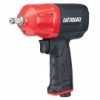Harbor Freight Tools 63061 User Manual - Page 13
Troubleshooting
 |
View all Harbor Freight Tools 63061 manuals
Add to My Manuals
Save this manual to your list of manuals |
Page 13 highlights
Safety Troubleshooting Problem Possible Causes Likely Solutions Decreased output. 1. Not enough air pressure and/ or air flow. 1. Check for loose connections and make sure that air supply is providing enough air flow (CFM) at required pressure (PSI) to the tool's air inlet. Do not exceed maximum air pressure. 2. Obstructed trigger. 2. Clean around trigger to ensure free movement. 3. Incorrect lubrication or not enough lubrication. 3. Lubricate using air tool oil and grease according to directions. 4. Blocked air inlet screen (if equipped). 4. Clean air inlet screen of buildup. 5. Air leaking from loose housing. 5. Make sure housing is properly assembled and tight. 6. Mechanism contaminated. Severe air leakage. 1. Cross‑threaded housing (Slight air leakage components. is normal, especially on older tools.) 2. Loose housing. 6. Have qualified technician clean and lubricate mechanism. Install in-line filter in air supply as stated in Setup: Air Supply. 1. Check for incorrect alignment and uneven gaps. If cross-threaded, disassemble and replace damaged parts before use. 2. Tighten housing assembly. If housing cannot tighten properly, internal parts may be misaligned. Technician needs to disassemble tool, align parts and reassemble. 3. Damaged valve or housing. 3. Replace damaged components. 4. Dirty, worn or damaged valve. 4. Clean or replace valve assembly. Housing heats during use. Worn parts. Have qualified technician inspect internal mechanism and replace parts as needed. Follow all safety precautions whenever diagnosing or servicing the tool. Disconnect air supply before service. Setup Operation Maintenance Item 63061 62835 For technical questions, please call 1-888-866-5797. Page 13













